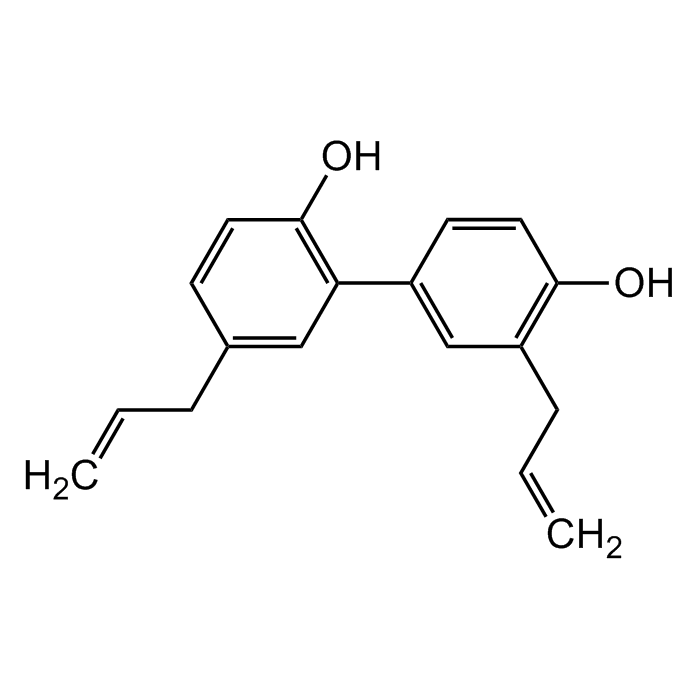Cookie Policy: This site uses cookies to improve your experience. You can find out more about our use of cookies in our Privacy Policy. By continuing to browse this site you agree to our use of cookies.
Chemodex
Honokiol

| Product Details | |
|---|---|
| Synonyms | 5,3'-Diallyl-2,4'-dihydroxybiphenyl; NSC 293100 |
| Product Type | Chemical |
| Properties | |
| Formula |
C18H18O2 |
| MW | 266.33 |
| CAS | 35354-74-6 |
| Source/Host Chemicals | Plant |
| Purity Chemicals | ≥98% (HPLC) |
| Appearance | Light brown powder. |
| Solubility | Soluble in DMSO (30mg/ml), DMF (30mg/ml) or ethanol (30mg/ml). |
| Identity | Determined by 1H-NMR. |
| Declaration | Manufactured by Chemodex. |
| Other Product Data |
Click here for Original Manufacturer Product Datasheet |
| InChi Key | FVYXIJYOAGAUQK-UHFFFAOYSA-N |
| Smiles | OC1=C(C2=CC(CC=C)=C(O)C=C2)C=C(CC=C)C=C1 |
| Shipping and Handling | |
| Shipping | AMBIENT |
| Short Term Storage | +4°C |
| Long Term Storage | +4°C |
| Handling Advice | Protect from light and moisture. |
| Use/Stability | Stable for at least 2 years after receipt when stored at +4°C. |
| Documents | |
| Product Specification Sheet | |
| Datasheet |
 Download PDF Download PDF |
Honokiol is a natural product derived from parts of the plant M. grandiflora used in Oriental herbal medicine. It is a lignan with diverse biological activities, including anticancer, neuroprotective, antithrombotic, anti-inflammatroy, antioxidant, antiviral, analgesic, antimicrobial, metabolic and GABA-modulating properties. Honokiol exerts broad-range anticancer activity in vitro and in vivo such as induction of cell cycle arrest and apoptosis, inhibition of epithelial-mesenchymal transition, inhibiting cell migration, invasion, and metastasis, as well as inducing anti-angiogenesis activity. Honokiol has neuroprotective effects based on its potent antioxidant activity, blockade of glutamate receptors and reduction in neuroinflammation. Honokiol also blocks inflammatory factor production in glial cells through the inhibition on NF-κ activation. It protects against lipid peroxidation by interfering with ROS production and migration. It regulates gamma-aminobutyric acid (GABA) A receptors and it also prevents platelet aggregation. Honokiol has been shown to inhibit hepatitis C virus (HCV) infection in vitro and described as a non-adipogenic PPARγ agonist.
(1) Y. Fukuyama, et al.; Bioorg. Med. Chem. Lett. 12, 1163 (2002) | (2) K.-T. Liou, et al.; Brain Res 992, 159 (2003) | (3) X. Bai, et al.; J. Biol. Chem. 278, 35501 (2003) | (4) H. Hu, et al.; Acta Pharmacol. Sin. 26, 1063 (2005) | (5) K.S. Ahn, et al.; Mol. Cancer Res. 4, 621 (2006) | (6) S. Dikalov, et al.; Biochem. Pharmacol. 76, 589 (2008) | (7) B.H. Kim J.Y. Cho; Acta. Pharmacol. Sin. 29, 113 (2008) | (8) L.E. Fried & J.L. Arbiser; Antioxid. Redox Signal. 11, 1139 (2009) (Review) | (9) L.K. Chao, et al.; J. Agric. Food Chem. 58, 3472 (2010) | (10) J.L. Shen, et al.; Molecules 15, 6452 (2010) (Review) | (11) K.H. Lan, et al.; Liver Internat. 32, 989 (2012) | (12) A.G. Atanasov, et al.; Biochim. Biophys. Acta 1830, 4813 (2013) | (13) A. Kumar, et al.; Future Med. Chem. 5, 809 (2013) (Review) | (14) A. Woodbury, et al.; Front. Neurol. 4, 130 (2013) (Review) | (15) S. Talarek, et al.; Biofactors 43, 760 (2017) (Review) | (16) C.P. Ong, et al.; Cancers 12, E48 (2019) (Review





